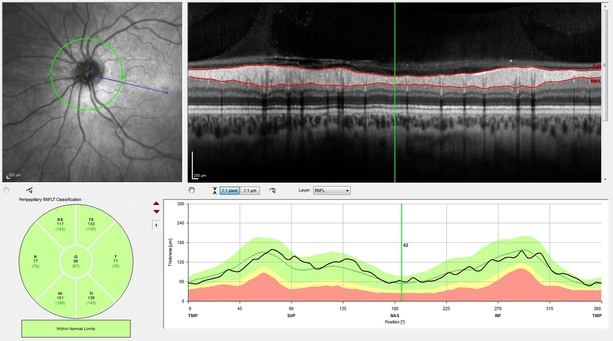Glaucoma Retinal Nerve Fibre Imaging
Firstly it's worth understanding what glaucoma is, before we explain how important it is to diagnose it early and how we do it... So what is glaucoma?
Glaucoma is a very common eye condition, and is often called the silent thief of sight as it has no symptoms until it is well established, often creeping up and stealing your sight before you are aware there is a problem. When symptoms do become noticeable, it's usually only when significant loss of vision (40% or more) has occurred. It's therefore especially important that everyone understands the need for regular advanced glaucoma eye examinations which can detect the condition long before most opticians and certainly long before you notice it and stop you needlessly losing your sight.
Glaucoma is a major cause of blindness in the world - Primary Open Angle Glaucoma. (POAG) being the most common form.
You do NOT need to have a family history of glaucoma to develop the condition. (although a strong family history does increase your risk)
The prevalence increases with age. Approximately 2% of the population have glaucoma. It is estimated that by 80 years old as many as one in ten people may have the condition (although a significant proportion are undiagnosed).
Glaucoma explained simply- Inside your eye a fluid called the aqueous constantly circulates. This fluid exerts a pressure on the optic nerve at the back of your eye and the fine layers of nerves on your retina all day every day. If this pressure is too high or the nerves at the back of your eye have a weakness the nerve fibers will gradually be compressed and the blood supply restricted. Left undetected or untreated the compression of the nerves causes them to gradually die off and stop functioning - the result of which is losing patches of vision possibly resulting in blindness. Glaucoma can affect anyone but certain groups are more susceptible including those with short-sightedness, poor circulation, diabetes, high blood pressure, migraine sufferers, or of African-Caribbean origin. The good news is that glaucoma is usually very manageable using eye drops and early diagnosis can prevent any significant vision loss at all in 90% of people who are diagnosed early.
Therefore early diagnosis is imperative. Although relevant, the traditional pressure test alone is not an accurate test for glaucoma. You do not need high intra-ocular pressures to develop glaucoma. If you have a nerve weakness, damage can occur even at low pressures this is called Normal Tension Glaucoma. It is also equally possible to have very high pressures but if the nerves are strong, no damage may occur this is called Ocular Hypertension.
Most opticians rely on pressure testing and visual field testing to detect glaucoma but using these traditional techniques alone can mean that up to 40% of the nerve fibre layer at the back of the eye may have already been lost by the time the tests show it up. Any nerve damage is permanent and therefore we need to detect nerve damage at a much earlier stage to allow us to save more of your eye sight.
Happily, there is a better way - using our Heidelberg Spectralis 4D Optical Coherence Tomographer eye scanner which uses a very safe low-powered imaging laser, we can accurately measure the thickness of the nerve fibre layer. It is a safe, non-invasive technique and doesn’t use any harmful rays like x-rays. These tests can detect any nerve damage up to 3-5 years earlier than conventional methods, which means treatment can be started sooner. The scans not only confirm the presence of glaucoma, but also provide a baseline to accurately detect any abnormal loss of nerve fibres in the future thus allowing more accurate management of the condition. When used in conjunction with pressure measurement and visual field testing there is the more accurate way of detecting glaucoma. Again unlike most opticians we now also look at the distribution of your nerve fibres across the macula which is now understood to be another early sign of glaucoma in addition to the extra measurements that we take.

Closed angle glaucoma is a rarer form of glaucoma that can cause pain, blurring and quick onset sight loss. We can now scan your eyes and predict the likelihood of this occurring. If the scan identifies a risk you may, at any age, be entitled to preventative laser treatment which can stop closed angle glaucoma from occurring in the future.

If you have glaucoma and are on treatment it is still possible, in some cases for the condition to progress. It is also possible to have undiagnosed glaucoma, due to apparently normal eye pressures. Both of these scenarios can often be caused due to a fluctuation in eye pressures. We may know what your eye pressure is during the day when you attend your appointment, but we really have no idea what it is doing at 3am when it may peak considerably. Human bodies fluctuate. For years we have realised the importance of, and been able to, measure blood pressure over 24 hours. Now Buchanan Optometrists have become the first practice in the UK to be able to measure eye pressure over 24 hours. Thus helping to identify sight threatening peaks in eye pressure and treat you accordingly to prevent sight loss. And don't worry you will not have to pop into the practice at 3am! with your eye pressure. If you want to see how good your control is. Find out more about 24 hour pressure monitoring by clicking here.
Buchanan Optometrists Ltd is one of the few optometry practices in the UK to own the Heidelberg Spectralis Optical Coherence Tomographer Scanner widely regarded as the pinnacle in early glaucoma detection.
We recommend advanced glaucoma screening for everyone over 35. Book your appointment today and prevent sight loss. Call us on 01634 240645 or click the Call me back button at the top of this page.





